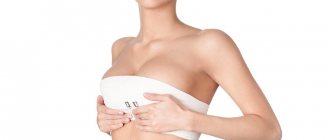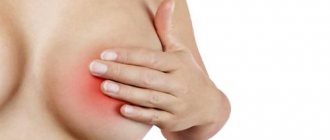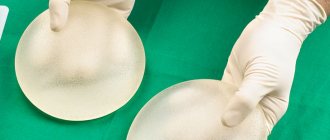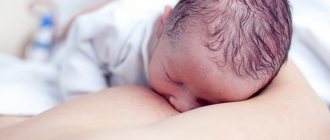Many women and girls face the problem of itchy breasts during breastfeeding (breastfeeding). This is most often due to the fact that milk comes in, the breasts increase in size, the skin stretches and begins to itch.
During milk production, during lactation, the milk ducts are filled with a large amount of milk, blood circulation increases significantly. This leads to changes in the size of the mammary glands and stretching of the skin.
This phenomenon is not considered a problem, but rather a common occurrence during breastfeeding, although it brings considerable discomfort, because the constant feeling of dryness, itching and flaking is exhausting and does not allow you to fully rest and take care of the child.
Typically, the breasts stop itching after the lactation process improves, milk is produced exactly as much as the baby needs, and the mammary glands take on a certain size.
Itchy breasts - possible causes
If a nursing mother has been bothered by itching in the breast area for a long time, first of all, she should not scratch it in order to avoid infection through cracks in the skin.
And of course, you need to understand the possible reasons why the mammary glands may still itch. Indeed, in some cases, when even with established lactation, the feeling of discomfort does not go away, itching may be a sign of other concomitant diseases. Here are the most common of them:
- nipple thrush;
- avitaminosis;
- mastitis;
- improper attachment during feeding.
Many mothers who are too busy caring for the baby may ignore painful and uncomfortable sensations. But if your breasts continue to itch, it is better to consult a doctor for examination and to identify possible causes.
It is necessary to consider in more detail all the possible signs of the above diseases that can provoke a constant desire to scratch the chest, as well as ways to combat them.
Thrush
The largest number of women begin to suffer from nipple candidiasis in the first weeks after starting to feed the baby. This is explained by the fact that feeding has not yet been established, the regularity of hygiene procedures has not been established, or during pregnancy the woman’s immunity has greatly decreased.
This means that it is easier for the fungus to multiply in the skin of the breast and nipples, which have not yet become stronger, have not become rough and could have been injured during the feeding process. What other reasons can cause the development of thrush:
- chronic disease candidiasis, which occurs in the body and recurs with manifestation in the nipple area;
- taking hormonal contraceptives;
- excessive consumption of sweet, starchy, salty foods;
- deep cracks in the nipples;
- diabetes.
An untreated infection can be transmitted to the baby during feeding, so you need to know what symptoms are accompanied by candidiasis. The main features include:
- unpleasant itching sensation around the nipples;
- redness and peeling of the skin;
- small scales and whitish blisters on the nipples;
- slight swelling.
If there is no pain, the presence of a disease in the mother may be signaled by the child’s restless behavior. After all, he also has manifestations of thrush in his mouth, which prevent him from fully sucking milk, the mucous membrane is itchy, the child often cries and refuses to eat due to pain.
It is necessary to treat candidiasis, but drugs that are suitable for this purpose must be prescribed by a doctor. Self-medication is not recommended at all, and doubly so during pregnancy and lactation. After all, it is unknown what kind of reaction this or that medication can give to the body of the mother and child. If ointments and gels that are applied externally can clog the milk ducts, then uncontrolled use of tablets inside can become downright dangerous. It is necessary to treat mother and child at the same time, because an untreated child will again introduce the infection into the mother’s body.
The easiest way to get rid of thrush can be regular baking soda. A teaspoon should be thoroughly dissolved in a glass of water with the resulting mixture regularly, and the child’s chest and affected areas in the child’s mouth should be treated throughout the day. Be sure to wipe the mammary glands with a soda solution before feeding and immediately after it.
If the fungus has severely affected the body, and the soda solution does not have the desired effect, the doctor may recommend applying Nystatin ointment to the skin. It is applied to the skin immediately after feeding and washing the nipples, and also 30 minutes before putting the baby to the breast. The mammary glands need sunbathing for 15–20 minutes, and also monitor hygiene. Wash your breasts regularly and sterilize everything that comes into contact with them - underwear, breast pump, breast pads.
In addition to external treatment, you need to start taking medications containing bifidobacteria and lactobacilli: they will help restore the correct microflora in the body. It is worth paying attention to your diet and the foods you eat. The exceptions for thrush should be soda, yeast products, sweets and fruits. You need to drink more green tea and fermented milk drinks.
You cannot stop the course of treatment immediately after the main signs of candidiasis have disappeared, because getting rid of this fungus is not so easy. If the disease is detected in a timely manner and treatment is started immediately, then the chances of getting rid of it will be many times higher than with an advanced stage of thrush. You should also try not to stop breastfeeding during the course of treatment. After all, you can overcome candidiasis quite quickly with some effort. At the same time, the child will continue to receive all the beneficial substances and vitamins contained in breast milk, which will support his immunity and overall health.
Common breast diseases during breastfeeding
Since the period of breastfeeding can last up to two years, it is clear that during this time the mother will face unforeseen situations. We are talking about diseases that can appear in a young mother during breastfeeding, but it is not at all necessary to wean the baby off the breast because of this.
Mastitis and lactostasis
The most common disease is mastitis or lactostasis. Most often, stagnation of milk occurs due to refusal to feed for a while or completely. Also, stagnation of milk can be caused by incorrectly selected underwear, namely a bra; it must be chosen in size so as not to squeeze the breasts. Another factor that affects this disease is chest contusion.
Lactostasis manifests itself through a sharp thickening in the chest area or severe pain when pressing on the mammary glands. There are cases when an infection gets inside the chest, the mammary glands become inflamed, and mastitis appears.
In these two cases, many mothers make the wrong decision and deliberately give up breastfeeding. Namely, it will help in the fight against these diseases. What to do?
First, you need to express a little milk, then attach the baby to a healthy breast, and then supplement the baby with formula. After putting a baby to the breast with stagnation of milk, it is clear that at first it will be painful, but this will help disperse the lumps that have formed. When feeding from a sore breast, try to change the position of the baby more often, this will help the milk flow in different directions, which will stimulate the dilution of stagnation.
Cracks
During breastfeeding, some women experience problems with their nipples, namely, they begin to crack, which brings unbearable pain. One of the main reasons for the appearance of cracked nipples is the incorrect position of the baby at the mother's breast. A young mother should know that in the child’s mouth there should be not only a nipple, but also an aureole. If the nipple has already cracked, it is necessary to urgently correct the situation with special creams. Also, one of the effective ways to combat cracks is mother’s milk itself. The first drops of milk should be spread over the nipple and areola, and this should be done before each feeding. It is also advisable to protect the nipple from the baby’s touch for a while; for this you need to purchase special breast pads for feeding.
Chest pain
In some cases, especially at the beginning of feeding, much more milk comes in than needed. Overflowing milk literally expands the breasts, causing them to become unbearably sore, reddened and hot and heavy. To correct the situation, you need to put the baby to the breast more often and in a few days everything will return to normal.
Infectious diseases
During the feeding period, a young mother may become ill with acute respiratory infections or the flu, but she should not give up breastfeeding. During this period, protective antibodies are formed in the milk, which, when transferred to the child, form his immunity. But do not forget that the disease can be transmitted by airborne droplets and through saliva; to avoid the risk of infecting your child, purchase a special mask and wear it constantly. Don't forget to change it at least every 3-4 hours. During these infectious diseases, paracetamol should be taken.
Don't forget one thing: no matter what worries you, you should immediately consult a doctor.
Author of the article: Sergeenkova Irina Olegovna
Mastitis
If a nursing mother's breasts itch, this may be a signal of developing mastitis. When the glands are not completely emptied of milk and the pumping process is ignored, the process of inflammation begins. The first symptom is severe itching, and if this sign is not paid attention to in time, the inflammation will worsen, turning into a purulent form. Itching occurs due to the appearance of cracks and microtraumas of the skin on the nipples, and through these cracks the infection penetrates deep into the gland.
The main symptoms of mastitis are:
- a sharp increase in body temperature, sometimes up to 38.5–39 degrees;
- feeling of a “burning” chest;
- soreness, itching.
In this case, contacting a doctor is mandatory; as a pre-medical measure, you can use an ice compress wrapped in thick cloth.
If the temperature is low and the woman’s general condition is satisfactory, conservative treatment is prescribed. Antibiotics are used that are compatible with continued breastfeeding, but if there are indications for this, breastfeeding should be stopped for a while. It is possible to prescribe physiotherapy (usually at the recovery stage). High fever can be reduced with water and vinegar, cool compresses or showers, and paracetamol.
If mastitis has entered the stage of a purulent inflammatory process, surgical intervention is indicated.
The best prevention of this disease is to completely empty the breast after feeding. After the breast has been emptied, it may be helpful to apply ice to the breast for 5 to 10 minutes to relieve swelling and heat. You need to put your baby to the breast as often as possible: he became infected with the infection even before the first manifestations of the disease, and with mother’s milk the baby will receive not only harmful microbes, but also immunity against them.
Two stages
At the first stage of the disease, swelling, thickening, engorgement of the gland and redness (sometimes quite bright) appear. The patient is chilling and has nagging pain and discomfort in the chest. Body temperature can rise to 38° C. If this happens to you, urgently rush to see a specialist: timely treatment will give positive results in two weeks and will save you from the very unpleasant consequences of the next stage of mastitis - purulent. It occurs with high fever - up to 40°, general weakness, headache, severe throbbing pain in the chest, discharge of purulent secretion from the nipple.
Miss the moment - the situation may become complicated to such an extent that surgical intervention is no longer possible. The specialist will be forced to open and remove the purulent contents or make an incision (and in case of extensive mastitis - several) and insert a drain so that the accumulated pus gradually comes out of the breast tissue. Usually, after purulent mastitis, scars remain, which, when prolonged, often deform the mammary gland, depriving it of its former attractiveness.
Many ladies, noticing that something wrong is happening with the mammary gland, try to treat themselves. Some begin to apply heating pads to the sore spot, others - ice. Such rough interventions can lead to serious complications.
And some sufferers just sit and wait for everything to resolve itself. Alas, it will not resolve! If you notice the first signs of illness, do not delay a visit to a specialist.
You also need to rush to see a doctor in order to get rid of painful doubts and fear. Many have heard that so-called mastitis-like cancer is disguised as mastitis, which is externally manifested by the same redness of the skin, thickening and engorgement of the mammary gland, but without an increase in body temperature. Only a doctor can make a diagnosis and allay fears.
Avitaminosis
The diet of a nursing mother should contain a complete set of vitamins, micro- and macroelements, fats and saturated acids. If your mammary glands itch during breastfeeding, this may be a sign that your body lacks vitamins. First of all, you need to establish a diet that provides the woman with all the necessary substances that are important for the health of both the mother and the child.
Flaky skin and itching are signs of a lack of vitamins A, E and C, as well as Zinc. You can include foods containing sufficient amounts of these vitamins in your menu or start taking special vitamin complexes that your doctor will prescribe.
Many have forgotten about the benefits of fish oil, but it contains Omega 3 acids, which will maintain a healthy nervous system, improve blood circulation and absorption of nutrients, in particular vitamin D. While taking fish oil, to get rid of the feeling of itching in the chest area, you need to take sunbathing and spend more time in the air.
Incorrect attachment to the breast
The consequences of improper breastfeeding technique include damage to the nipples, cracks and microtraumas of the skin, which can also cause constant scratching of the mammary glands. Itching and a feeling of discomfort appear when the baby rubs the skin of the nipple, trying to pull it in and pushing it back out during improper attachment.
Inexperienced mothers can be taught proper feeding techniques in the clinic or by nurses who come to their home. Usually, when the baby learns to grasp the entire areola around the nipple and fully suckle at the breast, the mother’s discomfort, including pain and itching, stops.
Causes and associated symptoms
Redness of the breast can be caused by various factors. One of the most common ones is the first weeks of feeding. As a rule, problems begin with the appearance of cracks in the nipples. The breasts become red during breastfeeding if a woman suffers from various diseases.
Cracked nipples
As soon as the baby begins to feed on mother's milk, women complain of cracked nipples. They do not appear immediately. At first, my breasts hurt during feeding. After some time, red spots appear. After 3-4 days, the red areas bleed.
Lactostasis
Women call this problem the most pressing, since almost all mothers face it. The main symptom of the disease is breast hardness. If the mammary glands do not empty enough, this leads to blockage of the ducts.
In addition to pain, the woman develops a fever, her breasts become hard, and a certain area feels tight.
Lactostasis occurs due to the use of incorrect feeding techniques and premature weaning of the baby. Women experience lactostasis if they feed their children against their wishes.
Mastitis
The presence of lactostasis in a woman leads to the development of mastitis. Milk that is not promptly removed from the mammary glands leads to tissue swelling. In turn, they begin to become inflamed. The woman’s condition worsens, her breasts cannot be touched, and her body temperature rises.
Breast abscess
If a woman is diagnosed with mastitis and appropriate treatment is not prescribed, an abscess develops as a result of the disease. At the site of engorgement, the resulting cavity is filled with pus. It penetrates into milk, so feeding the child at the time of illness is suspended. An abscess often develops in only one breast.
After the examination, the doctor may allow the baby to be fed from a healthy mammary gland. In case of an abscess, self-medication is prohibited.
Hypogalactia
The appearance of lumps in the mammary glands is not the only problem women face. During breastfeeding, organs stop functioning. When the baby is born, the mother's breast does not produce milk. As a result, lactation is impossible.
There are no characteristic symptoms of hypogalactia. The breasts look normal, there is no redness. The mammary glands do not enlarge, but the child’s behavior changes. With hypogalactia, milk can be produced. But after 3-4 weeks the amount gradually decreases. There are no disturbances in the functioning of other organs.










